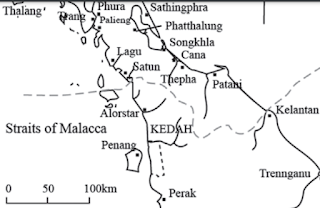Kedah, a port polity between the Indian Ocean and the South China Sea, was a strategic point of the East-West trade. Kedah with its ship-building centers and food resources was vital to the strategy.
On 12th November 1821, a large Siamese fleet sailed into Kuala Kedah massacred the garrison there and sailed on to Kuala Merbok looking for Sultan.
On that day, a large fleet of Siamese ships unexpectedly anchored off Kedah’s main port of Kuala Kedah. But soon the real objective of the Siamese visit became apparent when a heavily armed landing party slipped ashore, supported by more troops entering Kedah’s inland frontiers from the northern and eastern borders. It was well coordinated, swift and cruel. A full-scale military invasion left the country in ruins.
The Siamese failed to capture their main target, Sultan Ahmad Tajuddin of Kedah, who was compromised in Siamese eye by “treason correspondence with the Burmese”. The Sultan escaped because at the time of the attack he was away in the south of Kedah, with most of his family and following, superintending the building a channel to link the Merbau and Muda Rivers. The messenger bearing news of the Siamese assault reached the Sultan only just ahead of his pursuers.
During the years that followed 1821-1839 Bangkok set-up direct control over her former tributary with a Siamese governor and a handful of Siamese officials to run the state as a Siamese province and a standing army to back up the authority of the new rulers.
In 1896, Kedah along with Perlis and Setul was combined into the Siamese province of Monthon Syburi which lasted until transferred to the British by the Anglo-Siamese Treaty of 1909.
Siamese attacked Kedah in 1821
The Marvel of Agar-Agar: A Natural Gelling Agent
-
Agar-agar, a substance prized globally, functions as an exceptionally
effective binding and gelling agent across numerous applications, from
culinary arts ...





